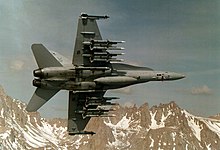VX-4
| Air Test and Evaluation Squadron 4 | |
|---|---|
| Active | 1952 to 30 September 1994 |
| Country | United States |
| Branch | United States Navy |
| Garrison/HQ | Naval Air Station Point Mugu |
| Nickname(s) | "The Evaluators" |
VX-4, Air Test and Evaluation Squadron Four, (AIRTEVRON FOUR), commonly referred to by its nickname of The Evaluators, was a
History
There were two squadrons which used the designation VX-4. The first was established in 1946 as Experimental and Development squadron Four at NAS Quonset Point equipped with
The second squadron to carry the VX-4 designation was established in 1952 at NAS Point Mugu to conduct evaluations of air-launched guided missiles as assigned by the Commander, Operational Test and Evaluation Force. That squadron is the subject of this article.
In 1960 the squadron began to include additional projects that were not associated with guided missiles. Projects such as the operational test and terrain clearance radar, Doppler navigation systems, and air-to-air distance measuring equipment were included in the squadron's tasks.

VX-4 flew aircraft that were currently in operational service with the US Navy, and began their life with the
Operational tests and evaluation of airborne fighter weapons systems included the AIM-7 Sparrow, AIM-9 Sidewinder and the AIM-54 Phoenix missiles as well as radar warning devices and self-protection jammers.

January 1990 marked the end of the F-4 Phantom after nearly three decades of service with VX-4 and a few months later the F-14D Super Tomcat arrived. Also the same year they supervised the first operational test of the F-14D and the
After Iraq's invasion of

After Desert Storm, the tempo at VX-4 returned to a more normal pace. AMRAAM testing aboard F/A-18, which began in 1991 and continued throughout the year. Evaluation of the F-14D, that had begun in 1990, likewise continued. Other 1991 projects included testing the
By late 1993, Hornet testing was winding down at VX-4 and preparations were underway for the transfer of all F/A-18 projects and F/A-18C/D aircraft to
See also
- History of the United States Navy
- List of inactive United States Navy aircraft squadrons
- List of United States Navy aircraft squadrons
References
- ^ Naval Aviation News Aug 1947 pg 24
External links

